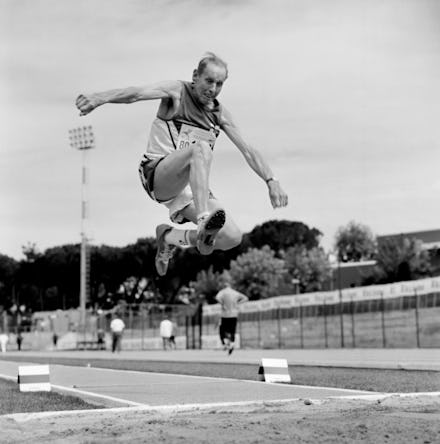10 Inspirational Photos Prove You Can Be an Athlete at Any Age

Athletes are the picture of youth and virility. Their sweat-glistened skin does not have a wrinkle on it. By all appearances, and especially as they are portrayed in the media, they seem untouchable and untouched by time.
It is no wonder that culture has firmly ensconced this image of the athlete in our mind. The average age of an Olympian in the 2012 games was 26. It is rare to see professional athletes in their 30s or 40s. For example, Serena Williams, who just won her 19th Grand Slam title last week after winning the Australian Open, is 33 — making her the oldest woman ever to win the tournament.
But do people stop being athletes as they age? Or is being an athlete a state of mind, something seared into a person's spirit?
These are precisely the questions photographer Angela Jimenez asked ahead of captivating audiences worldwide with her stunning photo series Racing Age, now on exhibit at United Art Industries in Brooklyn.
"When I started this project, I still had a young person's understanding of competition: that the peak performance of the young body is the ultimate accomplishment, "Jimenez said in an interview with Mic. "But I saw these athletes competing against age and against time. I found that really moving."
A college athlete herself, Jimenez was interested in thinking about the aging body in motion, and how the elder athlete bucks stereotypes about age. "I feel like there are two stereotypes of older people we see a lot: they are either weak or they are cute," she said. "Those both feel tired to me. I think the action photos are the most successful, because they really show what this is all about. They are out there competing in a really intense way."
"I wanted to observe how an older body moved through those motions, how older athletic bodies functioned. So the kinesiology of it was a starting point. How did they move?"
What she managed to portray in this series is simply inspirational. Her photographs capture the elder athlete in action, which makes us, the viewer, face aging — and death — head on. At the same time, these athletes are anything but feeble. They are stoic and tough competitors who are ready for any challenge.
Jimenez used a photographic technique to mirror the movement of the athletes. She deliberately shot with a manual Hasselblad camera, with 120mm roll film, to match the speed of her subjects. With the Hasselblad, she explained, "You manually measure the light and set the exposure and focus, then you shoot, then you crank to wind the film to the next frame. It is a very slow and deliberate way of shooting. ... But then, the metaphor also worked – that I was using a slower, older body just like the athletes were."
This is why photography is a special medium for Jimenez to create her art. It is, she says, a "beautiful, direct way of communicating that was both literal and metaphorical."
What her photographs illustrate, to varying degrees, is life in action; the life of the body, which is always aging, competes with the elements and with itself. "The level of competitiveness was the most surprising thing about photographing this project," she confesses. "I was just intrigued by the physicality of it at first. And then as I spoke to the athletes and spent more time observing, I saw how intensely competitive they were. They wanted to win."
"It is universal to have a fear of growing old and dying," Jimenez said, addressing how this series has resonated with audiences. "I think American/Western culture in general has become distanced from the direct care of our old. And our commercial culture is oriented to the young."
By focusing on an older demographic, Jimenez makes us acknowledge our own mortality; more importantly, she makes us confront our ageism and ageist culture. Instead of ignoring the reality of life and death, it is time that we face it head on – just like the athletes of her photos.
"What will a 90-year-old body be [capable of] doing in 20 years? In 100?" she wonders. "I hope that this project just shows something different and challenges some of those tired assumptions."